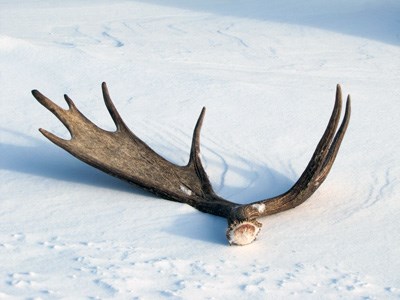
NPS Introduction The boreal forest, which is abundant in Voyageurs, is traditionally home for moose (Alces alces). Voyageurs is located in the southern portion of the moose's North American range and is one of only a few national parks in the lower 48 states where you have a chance to see one. Moose are the largest mammals found in the park and a glimpse of this massive animal can leave a lasting impression. Where can you view moose? Most of the moose within the park reside on the Kabetogama Peninsula. In the summer, your best chance of seeing a moose may be along the Cruiser Lake Trail or perhaps by a remote beaver pond where you might catch a moose stopping by for a drink in the early morning. Population The moose population within Voyageurs has remained fairly constant since the late 1990s, with an average of 40-50 moose. This is a low-density population compared to better habitat further east in Minnesota and Ontario. Status There are several reasons moose are declining across parts of Minnesota, including parasites, disease, predation, and heat stress during the summer months. Some of these factors do not kill a moose directly, but can weaken the animal and make it more susceptible to predation or malnutrition. Researchers are currently looking into how these factors will affect the long term status of moose in the state. 
Characteristics The average moose stands at a shoulder height of over six-feet and weighs nearly 1,000 pounds. This animal is well adapted to survive the harsh Minnesota winters. Its long legs aid in walking through deep snow and a dark brown coat helps the moose retain solar heat on the coldest winter days. Males have wide antlers and a bell (the flap of skin beneath the throat), making it easy to distinguish them from females most of the year. Breeding The mating season begins in mid-September when males start to rut, and continues through October. Females typically give birth to a single calf in late-spring, although twins are fairly common in areas of good habitat. How can you protect moose?
Contrary to trends in the state moose population, the population in Voyageurs has remained steady since at least 2009. Researchers are interested in understanding why this difference has occurred. From 2009 to 2013, 22 moose were captured and fitted with GPS collars. During capture, researchers took measurements and drew a blood sample to assess its overall health. The GPS collars record a precise location every hour, which can be used to look for patterns in movement and landscape use. Moose and the Future The future of moose in both Voyageurs and across Minnesota is uncertain. Projected warming and forest changes associated with climate change will likely further limit habitat quality for moose in Minnesota, including Voyageurs. For more wildlife exploration |
Last updated: February 2, 2023
